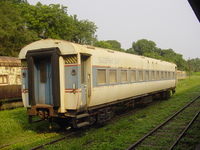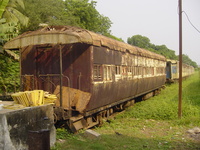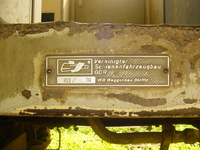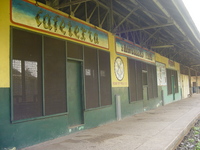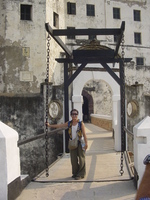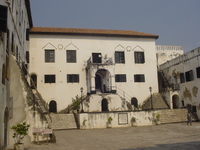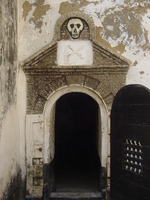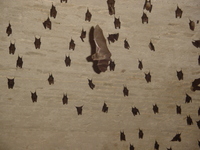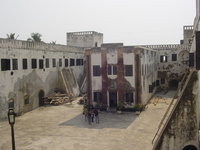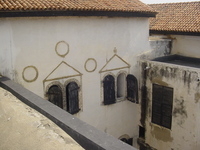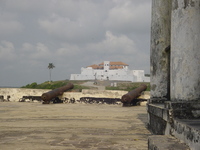We walked back to the station after dinner and boarded the train. The guard showed us to our cabins. We were at the front end of the carriage, with my cabin right next to the guard’s. He assured us that there was water and electricity. However until the engine arrived there would be no fan and the lights would be dim. I was glad to see that the sleeper carriage was at the back of the train, nice and far from the engine.
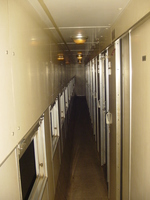
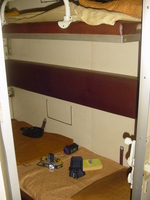
(more…)
George (?) from Ellis’s offered to go to the village with us to sort out a car. He took us to the chief’s house, where after five minutes a driver appeared and wanted ¢200,000 (£11), we walked away to the tro-tro station.
A shared taxi to Agona is apparently the standard ¢5000 each but there were no cars waiting so we hung around at the station. Eventually a taxi turned up empty but wasn’t running as a shared taxi, George had called him. We agreed ¢60,000.
At Agona there were no tro-tros to Cape Coast so we had to go back to Takoradi. We had lunch at a chop shop, rice and stew with chicken for ¢7000 (£0.40) then returned to the tro-tro station but it was the wrong one. We walked across town, which was full of kids and young men in multi-coloured outfits with masks. There was a carnival happening in the street outside the tro-tro station. We bought tickets for the next tro-tro, ¢12,000 because it was a “big car” with four cramped seats across (it’s ¢14,000 in a smaller van with three seats across).
I had a sleepy and uncomfortable journey to Cape Coast, where we were dropped near a market. Due to a lack of street signs it was tricky to work out where we were and taxi drivers kept hassling us. I eventually figured it out and we made our way to the Red Cross Hostel. This is probably the cheapest place to stay in Ghana, ¢80,000 for a self-contained room with three single beds! It’s quiet and clean, in the Victorian part of town.
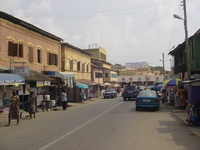
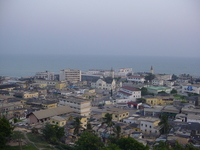
(more…)
The plan was to get up early and head straight to Busua but Dave had got a text from Susan (a Ghana VSO he’d met at training in the UK) saying that she was trying to find rooms for us close to where they were staying.
This meant that we didn’t know whether to head for Busua or Butre, so we went out to get some breakfast but everywhere was shut. A bit later we tried Bocadillo’s and I had two pain au chocolat and real coffee for ¢30,000 (£1.65).
We took a tro-tro to Agona junction for ¢5000 each but still hadn’t heard from Susan about accommodation. After a while we got a text saying she had organised three beds but with no mention of the cost! We were trying to decide whether to look for accommodation in Busua (where there are more options) or head to Butre to be with the group of Ghana VSOs.
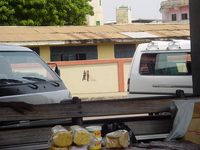 (“Do not urinate here!” sign at tro-tro station in Takoradi)
(“Do not urinate here!” sign at tro-tro station in Takoradi)
(more…)
We walked from the Fort of Good Hope up to Senya Beraku’s tro-tro station and took a shared taxi to the junction on the coast road for ¢5000 each. From there we picked up a tro-tro direct to Takoradi for about ¢10,000. It’s a fairly long journey and the coast road is being rebuilt in parts, which led to a very bumpy and dusty ride.
The authorities in Ghana actually seem to take road safety seriously. Even on major roads there are severe speed bumps at the entrance and exit of each village.
We managed to find our way to the Amenla hotel and checked in. I was in a single with shared bathroom at ¢70,000 per night, Marebec and Dave in an ¢80,000 double. The hotel is OK but seems a bit run down and the dark green and grey colour scheme in the rooms combined with the high ceilings, barred windows and feeble fans make it fairly grim.
For lunch we checked the guidebook and decided on the Silver Pot restaurant, which seems to have gone downhill a bit since 2003. The air conditioning was off and so were most of the items on the menu. In the end I had a beef stir fry that was mostly gristle.
After lunch we checked our email at the Unicon internet cafe, all the ones mentioned in the guidebook having closed. We went back to the hotel for a bit then out for dinner, finding a new place called Bocadillo’s at the end of the Old Asanti road. The menu had the usual Ghanaian and “continental” food with the surprising addition of Nigerian food. I had a nice vegetarian pizza for ¢45,000 (£2.50).
On the way back to the hotel I bought some mosquito coils, the mesh on the hotel windows is full of holes. Takoradi in general seems pretty run down. Open sewers run down both sides of the streets and down the centre of major streets, making the city stink. We saw a few huge rats scurrying around and some vultures picking through heaps of rubbish.
I’m writing this from an internet cafe in Takoradi, towards the western end of the Ghanaian coast.
We’ve been travelling west from Accra and it has been very enjoyable, some lovely beaches, colourful fishing harbours and the lurking leftovers of the slave trade in the form of trading forts (now serving as everything from prisons to hotels!).
Anyway, I’ll be on the beach on Christmas day, so I hope you enjoy yourselves too.
We walked from Big Milly’s up to Kokrobite junction, where the Metro Mass Transit bus from Accra was sitting. If we’d known about it we could have travelled from Accra to Kokrobite direct for ¢4000 each. We were heading to Senya Beraku, a little bit along the coast. We asked a taxi driver how much to go direct to Senya Beraku, he wanted about ¢500,000 (£27.50) so we just took a shared taxi up to the junction.
At the junction we started asking some other taxi drivers how much they wanted while we waited for a tro-tro. Our driver from Kokrobite reappeared and asked for the much more reasonable amount of ¢120,000 (£6.60), so we chartered.
The coast road has been recently upgraded to a dual carriageway with three lanes in each direction along this stretch. We sped along, passing a few police barriers but only had to stop at one and no bribe was required to get through. The road down to Senya Beraku was not so good, we bounced along between the potholes, through town and right to the end of the road: the Fort of Good Hope..
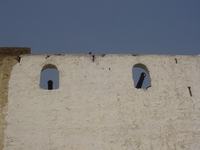
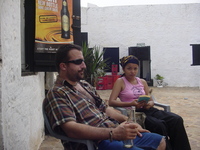
(more…)
After a relaxed start to the day we checked out of the Kokomlemle Guesthouse and walked along to the tro-tro (minibus) stop a little bit along the ring road. It took a while to find the right one, the driver’s mates aren’t constantly yelling out their destination like the Nigerian ones do.
We boarded a tro-tro for Kaneshie market and immediately got stuck in traffic at Nkrumah Circle, sweltering in the heat as soon as the bus stopped moving. After the traffic jam we transferred to another tro-tro, it cost a total of ¢1500 (8p) to get to Kaneshie.
The tro-tro station alongside Kaneshie market was total chaos, even worse than Jabi motor park in Abuja. After asking a few people we couldn’t find a tro-tro direct to Kokrobite, so we entered one going to Kasoa and told the driver we wanted to drop at the junction. This trip cost ¢3000 (16p) each plus ¢5000 (27p) each for a shared taxi to Kokrobite and an extra ¢5000 between us to drop at Big Milly’s Backyard.
Big Milly’s is a bunch of huts in various styles scattered around a lovely garden full of palm trees. Leo had called and booked for us, so Marebec, Dave and I were sharing a self-contained room with two double beds (although my bed was more like a large single, the left-hand photo below) for ¢260,000 (£14.30) per night.
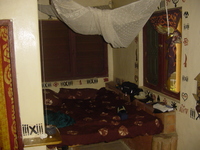
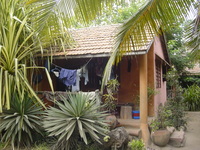
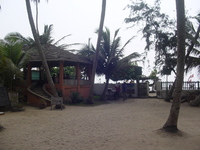
(more…)
Had to get up in the night because of mosquitoes and then a bit later with gut cramps, it seems that Club beer may not agree with me.
We had breakfast at the guesthouse, scrambled egg with toast and Laughing Cow processed cheese plus fresh orange juice for ¢16,000.
After collecting Karen from her hotel round the corner we found a bookshop just off the ring road nearby, seems to be mostly second-hand American books and too many self-help titles. We took a taxi to the National Museum to meet Leo (from Kabba), Sarah (a former VSO in Nigeria) and Pat (another priest working in Nigeria). The museum itself was quite small and probably not worth the ¢45,000 entrance fee, although there was an informative section on slavery. The best part of the museum is the restaurant in the grounds, where we had lunch. This was where Leo introduced me to Castle Milk Stout, a very nice local beer.
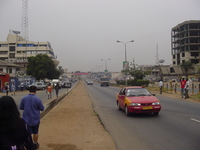
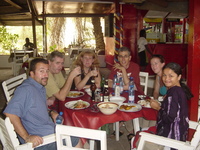
(more…)


![[Nigeria]](/media/Flags/NGflagSmall.png)
